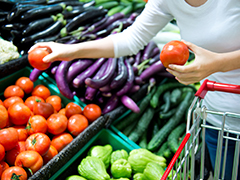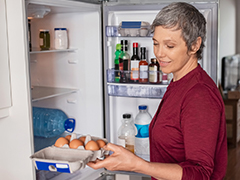Small Ways to Save Big on Groceries

We’ve all been there: you get your groceries, wait in line and watch the price go up and up above your budget as the cashier scans each item.
It’s no secret that healthy foods tend to cost more than processed, unhealthy products. According to one study, eating a healthy diet costs about $1.50 per day more than eating a less-than-healthy diet.
Make no mistake, even though fruits, vegetables, fish, and nuts may cost more than refined grains and processed meats at checkout, the latter is more expensive in the long run. Another study found that chronic conditions associated with poor diet, like heart disease, stroke and type 2 diabetes, account for nearly 18% of total health care costs in the U.S. every year.
Luckily, you don’t need to choose between saving on groceries and eating a balanced diet. With a little planning and savviness, you can have both. Try these tips from registered dietitians next time you’re at the grocery store.
Skip the big name brands
The ‘generic’ or ‘store-brand’ version of your favorite product? There’s a good chance it’s made by the same brand as the big name—without the hefty price tag.
And oftentimes with similar nutritional content, too. These products can cost up to a few dollars less than the name brands. Plus, those savings can be even deeper when you shop during a sale.
Make a plan based on the sales
Get creative with your meal planning! See what’s on sale at the store and base your meals around it. This way, you can stack the savings for deeper discounts while trying new recipes.
And if you see a deal on something you know you’ll need in the future, stock up on it. You can extend the shelf life of a lot of produce by throwing it in the freezer. Some other products naturally have a long shelf, like canned or dried goods.
Don’t fear the freezer
When you think of the frozen section, you might imagine frozen dinners and desserts. But it’s also home to frozen produce, including vegetables, fruit and fish. These products tend to be a lot cheaper than their unfrozen counterparts and of similar quality.
No, there isn’t a catch. Frozen products stay fresh for a long time—sometimes years—so it costs less for the grocery store to keep them on the shelves. Not to mention, in some cases frozen produce can be even fresher than unfrozen since they’re often frozen right after harvest.
Think about nonorganic
Organic produce can be as much as double the cost of conventionally grown produce. Consider only going for organic products that you eat entirely, like leafy greens and berries. But for things that have a peel, like bananas or avocados? There isn’t much difference between organic and nonorganic.
Find healthy foods that you love
The best way to eat a balanced diet and seek out savings is to find healthy foods you love. The Online Health Coach can help members reach their health goals, including eating right. It can help set and manage your goals, create a plan of care and track your progress.
Plus, Basic and Standard Option members can earn rewards after they complete the Blue Health Assessment and achieve up to three Online Health Coach goals.* You'll receive $40 for each eligible goal completed, up to three, for $120 total.
*You must be the contract holder or spouse, 18 or older, on a Standard or Basic Option plan to earn incentive rewards.
Source:
https://www.everydayhealth.com/diet-nutrition/how-save-money-on-groceries-when-eating-healthy/


